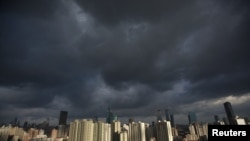Typhoon Haikui has hit eastern China, the third such storm to make landfall there in a week.
The storm came ashore in Zhejiang province early Wednesday bringing heavy rains and winds of up to 150 kilometers per hour.
More than 1.5 million people were evacuated ahead of the storm, which is expected to hover over Zhejiang province for most of Wednesday.
Shanghai, the country's financial center, avoided a direct hit. But forecaster Evan Duffey at the U.S.-based Accu-Weather tells VOA that Shanghai will continue to experience heavy rains.
"A lot of places are going to see torrential rains, as well, even if the winds die off pretty quickly here after it makes landfall," Duffey said. "And, the system is actually supposed to kind of loop around the Shanghai area before the moisture gets picked up by a front in a couple of days. So in general it looks like heavy rainfall over the next few days, at least for the Shanghai region."
The storm prompted the cancellation of numerous domestic and international flights from Shanghai's two airports. Some 30,000 boats have been at port since Sunday in anticipation of Haikui. All outdoor group activities have been banned. City parks and summer classes are cancelled, and outdoor construction has stopped.
The two earlier storms, Typhoons Damrey and Saola, also hit Zhejiang, causing flooding and landslides. Authorities say 23 people were killed and nine others are still missing.
The typhoons not only affected China, but other countries surrounding the South China Sea. This week, the Philippine capital, Manila, experienced landslides and flooding in the wake of Typhoon Saola.
At least 20 people have died in Manila as the result of flooding powered by more than a week of monsoon rains. Officials, who say half of the city has been turned into a "water world," report that the flooding has now eased, but that most of the city remains under water.
Beth Tiu, a humanitarian relief director for World Vision in Manila, tells VOA the situation is worse than in 2009, when Typhoon Ketsana left hundreds dead and $1 billion in damage.
"[The] rains that poured in [are] much much greater than Tyhpoon Ketsana," Tiu said. "The water level is much deeper than the previous one. But the good thing is that because of the previous experience, the people are now more prepared."
World Vision is appealing for $800,000 in funds for humanitarian supplies for some of the hundreds of thousands of people affected by the floods.
The storm came ashore in Zhejiang province early Wednesday bringing heavy rains and winds of up to 150 kilometers per hour.
More than 1.5 million people were evacuated ahead of the storm, which is expected to hover over Zhejiang province for most of Wednesday.
Shanghai, the country's financial center, avoided a direct hit. But forecaster Evan Duffey at the U.S.-based Accu-Weather tells VOA that Shanghai will continue to experience heavy rains.
"A lot of places are going to see torrential rains, as well, even if the winds die off pretty quickly here after it makes landfall," Duffey said. "And, the system is actually supposed to kind of loop around the Shanghai area before the moisture gets picked up by a front in a couple of days. So in general it looks like heavy rainfall over the next few days, at least for the Shanghai region."
The storm prompted the cancellation of numerous domestic and international flights from Shanghai's two airports. Some 30,000 boats have been at port since Sunday in anticipation of Haikui. All outdoor group activities have been banned. City parks and summer classes are cancelled, and outdoor construction has stopped.
The two earlier storms, Typhoons Damrey and Saola, also hit Zhejiang, causing flooding and landslides. Authorities say 23 people were killed and nine others are still missing.
The typhoons not only affected China, but other countries surrounding the South China Sea. This week, the Philippine capital, Manila, experienced landslides and flooding in the wake of Typhoon Saola.
At least 20 people have died in Manila as the result of flooding powered by more than a week of monsoon rains. Officials, who say half of the city has been turned into a "water world," report that the flooding has now eased, but that most of the city remains under water.
Beth Tiu, a humanitarian relief director for World Vision in Manila, tells VOA the situation is worse than in 2009, when Typhoon Ketsana left hundreds dead and $1 billion in damage.
"[The] rains that poured in [are] much much greater than Tyhpoon Ketsana," Tiu said. "The water level is much deeper than the previous one. But the good thing is that because of the previous experience, the people are now more prepared."
World Vision is appealing for $800,000 in funds for humanitarian supplies for some of the hundreds of thousands of people affected by the floods.









